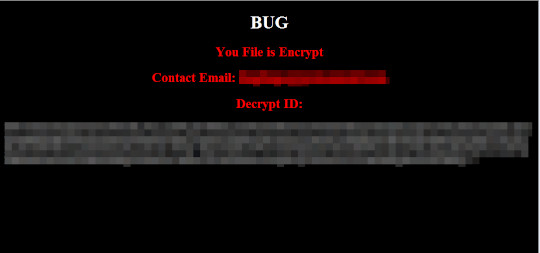Ransom.Win64.BUGO.A
Trojan-Ransom.FileCrypter (IKARUS); W64/Filecoder.BP!tr.ransom (FORTINET)
Windows


Threat Type: Ransomware
Destructiveness: No
Encrypted: No
In the wild: Yes
OVERVIEW
This Ransomware arrives on a system as a file dropped by other malware or as a file downloaded unknowingly by users when visiting malicious sites.
It executes then deletes itself afterward.
It encrypts files with specific file extensions. It encrypts files found in specific folders. It drops files as ransom note.
TECHNICAL DETAILS
Arrival Details
This Ransomware arrives on a system as a file dropped by other malware or as a file downloaded unknowingly by users when visiting malicious sites.
Installation
This Ransomware drops the following copies of itself into the affected system:
- %User Temp%\temp.exe
(Note: %User Temp% is the current user's Temp folder, which is usually C:\Documents and Settings\{user name}\Local Settings\Temp on Windows 2000(32-bit), XP, and Server 2003(32-bit), or C:\Users\{user name}\AppData\Local\Temp on Windows Vista, 7, 8, 8.1, 2008(64-bit), 2012(64-bit) and 10(64-bit).)
It adds the following processes:
- %System%\cmd.exe /c start %User Temp%\temp.exe
- %System%\cmd.exe /c ping 127.0.0.1 & del %User Temp%\temp.exe
- %System%\cmd.exe /c start %Desktop%\Read_Bug.html
(Note: %User Temp% is the current user's Temp folder, which is usually C:\Documents and Settings\{user name}\Local Settings\Temp on Windows 2000(32-bit), XP, and Server 2003(32-bit), or C:\Users\{user name}\AppData\Local\Temp on Windows Vista, 7, 8, 8.1, 2008(64-bit), 2012(64-bit) and 10(64-bit).. %Desktop% is the current user's desktop, which is usually C:\Documents and Settings\{User Name}\Desktop on Windows 2000(32-bit), XP, and Server 2003(32-bit), or C:\Users\{user name}\Desktop on Windows Vista, 7, 8, 8.1, 2008(64-bit), 2012(64-bit) and 10(64-bit).)
It executes then deletes itself afterward.
Ransomware Routine
This Ransomware encrypts files with the following extensions:
- .7z
- .cs
- .db
- .gz
- .js
- .py
- .aac
- .asp
- .avi
- .bak
- .bat
- .bmp
- .cmd
- .com
- .cpp
- .css
- .csv
- .dbf
- .doc
- .exe
- .gif
- .htm
- .ico
- .jpg
- .jsp
- .lua
- .m3u
- .m4a
- .mdb
- .mid
- .mkv
- .mov
- .mp3
- .mp4
- .mpa
- .mpg
- .odt
- .ogg
- .pdb
- .php
- .png
- .ppt
- .psd
- .rar
- .rtf
- .sql
- .tif
- .txt
- .wav
- .xls
- .xml
- .zip
- .aspx
- .docx
- .html
- .java
- .jpeg
- .json
- .pptx
- .xlsx
It encrypts files found in the following folders:
- Drives A to Z
- %Desktop%
- %User Profile%\My Documents
(Note: %Desktop% is the current user's desktop, which is usually C:\Documents and Settings\{User Name}\Desktop on Windows 2000(32-bit), XP, and Server 2003(32-bit), or C:\Users\{user name}\Desktop on Windows Vista, 7, 8, 8.1, 2008(64-bit), 2012(64-bit) and 10(64-bit).. %User Profile% is the current user's profile folder, which is usually C:\Documents and Settings\{user name} on Windows 2000(32-bit), XP, and Server 2003(32-bit), or C:\Users\{user name} on Windows Vista, 7, 8, 8.1, 2008(64-bit), 2012(64-bit) and 10(64-bit).)
It avoids encrypting files found in the following folders:
- Windows
- Program Files
- Users
- Program Files (x86)
- ProgramData
- Recovery
- PerfLogs
- Folder Name that contains any of the following special characters: $&()*+
- Folder Name that contains the string: System
It appends the following extension to the file name of the encrypted files:
- .bugbugo@{BLOCKED}mail.com].bug
It drops the following file(s) as ransom note:
- %Desktop%\Read_Bug.html
- %User Profile%\My Documents\Read_bug.html
- {Encrypted Folder}\Read_bug.html

SOLUTION
Step 1
Before doing any scans, Windows 7, Windows 8, Windows 8.1, and Windows 10 users must disable System Restore to allow full scanning of their computers.
Step 2
Note that not all files, folders, and registry keys and entries are installed on your computer during this malware's/spyware's/grayware's execution. This may be due to incomplete installation or other operating system conditions. If you do not find the same files/folders/registry information, please proceed to the next step.
Step 3
Search and delete this file
- %Desktop%\Read_Bug.html
- %User Profile%\My Documents\Read_Bug.html
- {Encrypted Folder}\Read_bug.html
Step 4
Scan your computer with your Trend Micro product to delete files detected as Ransom.Win64.BUGO.A. If the detected files have already been cleaned, deleted, or quarantined by your Trend Micro product, no further step is required. You may opt to simply delete the quarantined files. Please check the following Trend Micro Support pages for more information:
Step 5
Restore encrypted files from backup.
Did this description help? Tell us how we did.

